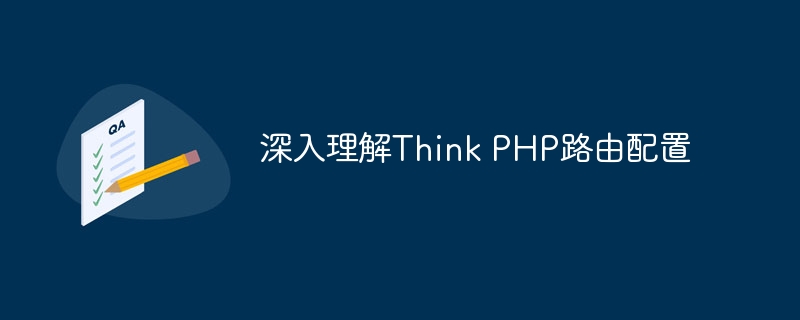Home >Backend Development >PHP Tutorial >In-depth understanding of Think PHP routing configuration
In-depth understanding of Think PHP routing configuration
- WBOYOriginal
- 2024-03-23 08:00:111333browse

In-depth understanding of Think PHP routing configuration requires specific code examples
Think PHP is a PHP framework based on the MVC pattern, and its routing configuration It is a very important part of the framework. Understanding and mastering routing configuration can help developers better organize and manage their projects, and improve the maintainability and scalability of the code. In this article, we will delve into Think PHP's routing configuration and give specific code examples.
1. Basic concepts of routing configuration
In Think PHP, routing configuration can be simply understood as the mapping relationship between URL and controller methods. Through routing configuration, we can define the corresponding controller methods when accessing different URLs, thereby achieving page access and data processing.
2. Routing configuration methods
Think PHP provides two common routing configuration methods: basic routing and complete routing.
Basic routing is the simplest routing configuration method. Routing can be implemented by specifying the URL and the corresponding controller method in the configuration file. For example:
// 默认路由配置
'URL_ROUTER_ON' => true, // 开启路由
'URL_ROUTE_RULES' => array(
'home' => 'Index/index', // 将URL "/home" 映射到 Index 控制器的 index 方法
'article' => 'Blog/read', // 将URL "/article" 映射到 Blog 控制器的 read 方法
),Complete routing is a more flexible and detailed routing configuration method that can be used for more accurate matching through regular expressions and other methods. For example:
// 完全路由配置
'URL_ROUTER_ON' => true, // 开启路由
'URL_ROUTE_RULES' => array(
'admin/:controller/:action' => 'admin/:1/:2', // 将URL "/admin/Post/edit" 映射到 admin 模块中对应的控制器和方法
),3. Example demonstration
We take a simple blog system as an example to demonstrate how to configure routing in Think PHP. Suppose we have a Blog controller, which includes the read method to display the article content.
First, perform basic routing configuration in the routing configuration file (usually config.php):
'URL_ROUTER_ON' => true,
'URL_ROUTE_RULES' => array(
'article/:id' => 'Blog/read', // 将URL "/article/123" 映射到 Blog 控制器的 read 方法,并传递文章ID作为参数
),Then, in the Blog controller readMethod written in:
public function read($id) {
$article = BlogModel::find($id); // 假设BlogModel是操作文章数据的模型
$this->assign('article', $article); // 将文章数据传递到模板中
$this->display(); // 展示文章模板
}Finally, display the content of the article in the template file:
<h1>{$article.title}</h1>
<p>{$article.content}</p>Through the above configuration and code examples, we successfully implemented the implementation in Think PHP The function of accessing the corresponding controller method according to the URL and displaying the article content.
Conclusion
This article deeply discusses the routing configuration of Think PHP from the basic concepts, configuration methods and example demonstrations of routing configuration. I hope it can help readers better understand and apply routing configuration. Improve the efficiency and quality of project development. In practical applications, flexible routing configuration can be performed according to project requirements and business logic, providing strong support for the smooth operation of the project.
The above is the detailed content of In-depth understanding of Think PHP routing configuration. For more information, please follow other related articles on the PHP Chinese website!

